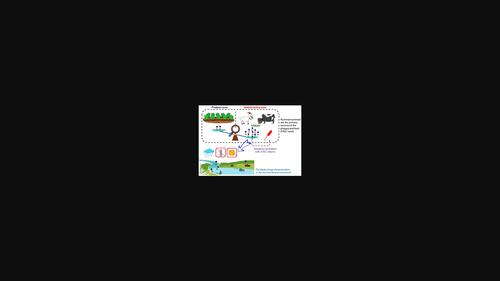当前位置:
X-MOL 学术
›
J. Food Saf.
›
论文详情
Our official English website, www.x-mol.net, welcomes your
feedback! (Note: you will need to create a separate account there.)
The effects of environmental factors on the prevalence and diversity of bacteriophages lytic against the top six non-O157 Shiga toxin-producing Escherichia coli on an organic farm
Journal of Food Safety ( IF 1.9 ) Pub Date : 2020-10-19 , DOI: 10.1111/jfs.12865 Yen‐Te Liao 1 , Valerie M. Lavenburg 1 , Marion Lennon 1 , Alexandra Salvador 1 , Angeline L. Hsu 1 , Vivian C. H. Wu 1
Journal of Food Safety ( IF 1.9 ) Pub Date : 2020-10-19 , DOI: 10.1111/jfs.12865 Yen‐Te Liao 1 , Valerie M. Lavenburg 1 , Marion Lennon 1 , Alexandra Salvador 1 , Angeline L. Hsu 1 , Vivian C. H. Wu 1
Affiliation

|
Bacteriophages (or phages) specific to Shiga toxin-producing Escherichia coli (STEC) strains are frequently isolated from animal-associated environments primarily because ruminant animals are the natural reservoir of STEC. However, little is known about these phages in produce-growing environments. The objective of this study was to determine the effects of environmental factors on the prevalence of the phages lytic against O157 and the top six non-O157 STEC on an organic farm. A total of 370 samples were collected from an organic farm, containing animal-active and produce-growing areas, for 1 year. A bacterial cocktail, including nonpathogenic and pathogenic E. coli strains, was used for phage isolation. Meanwhile, culture methods and PCR were used to isolate STEC strains. Weather information was also collected for each sampling trip. Twenty-eight samples contained phages lytic against STEC (or STEC-infecting phages), of which 26 were collected from the animal-active area. Moreover, the winter season had a higher phage prevalence than other seasons, likely due to high rain precipitation. The phages belonging to the Myoviridae family and those lytic against STEC O103 were the most prevalent. One E. coli O103:H2 was isolated from a water sample where no STEC O103-infecting phages were found. Additionally, no STEC O103 was present in the samples containing STEC O103-infecting phages. The findings indicate that animal is the primary factor contributing to the prevalence of the STEC-infecting phages in the surrounding environment of the organic farm, and the presence of these phages contributes to a negative correlation with their STEC hosts.
中文翻译:

环境因素对有机农场中前六大非 O157 产志贺毒素大肠杆菌的噬菌体流行率和多样性的影响
产志贺毒素大肠杆菌(STEC) 菌株特有的噬菌体(或噬菌体)经常从动物相关环境中分离出来,这主要是因为反刍动物是 STEC 的天然宿主。然而,人们对农产品生长环境中的这些噬菌体知之甚少。本研究的目的是确定环境因素对有机农场中针对 O157 和排名前六的非 O157 STEC 的噬菌体流行率的影响。从一个有机农场收集了 370 个样本,该农场包含动物活动区和农产品种植区,为期 1 年。一种细菌混合物,包括非致病性和致病性大肠杆菌。大肠杆菌菌株,用于噬菌体分离。同时,采用培养法和PCR法分离STEC菌株。还为每次采样旅行收集了天气信息。28 个样本含有针对 STEC 的裂解噬菌体(或感染 STEC 的噬菌体),其中 26 个是从动物活动区域收集的。此外,冬季的噬菌体流行率高于其他季节,这可能是由于降雨较多。属于Myoviridae家族的噬菌体和那些对 STEC O103 有裂解作用的噬菌体最为普遍。一个E。 _ 大肠杆菌O103:H2 是从未发现感染 STEC O103 的噬菌体的水样中分离出来的。此外,含有 STEC O103 感染噬菌体的样品中不存在 STEC O103。研究结果表明,动物是导致有机农场周围环境中感染 STEC 的噬菌体流行的主要因素,并且这些噬菌体的存在与其 STEC 宿主呈负相关。
更新日期:2020-10-19
中文翻译:

环境因素对有机农场中前六大非 O157 产志贺毒素大肠杆菌的噬菌体流行率和多样性的影响
产志贺毒素大肠杆菌(STEC) 菌株特有的噬菌体(或噬菌体)经常从动物相关环境中分离出来,这主要是因为反刍动物是 STEC 的天然宿主。然而,人们对农产品生长环境中的这些噬菌体知之甚少。本研究的目的是确定环境因素对有机农场中针对 O157 和排名前六的非 O157 STEC 的噬菌体流行率的影响。从一个有机农场收集了 370 个样本,该农场包含动物活动区和农产品种植区,为期 1 年。一种细菌混合物,包括非致病性和致病性大肠杆菌。大肠杆菌菌株,用于噬菌体分离。同时,采用培养法和PCR法分离STEC菌株。还为每次采样旅行收集了天气信息。28 个样本含有针对 STEC 的裂解噬菌体(或感染 STEC 的噬菌体),其中 26 个是从动物活动区域收集的。此外,冬季的噬菌体流行率高于其他季节,这可能是由于降雨较多。属于Myoviridae家族的噬菌体和那些对 STEC O103 有裂解作用的噬菌体最为普遍。一个E。 _ 大肠杆菌O103:H2 是从未发现感染 STEC O103 的噬菌体的水样中分离出来的。此外,含有 STEC O103 感染噬菌体的样品中不存在 STEC O103。研究结果表明,动物是导致有机农场周围环境中感染 STEC 的噬菌体流行的主要因素,并且这些噬菌体的存在与其 STEC 宿主呈负相关。









































 京公网安备 11010802027423号
京公网安备 11010802027423号